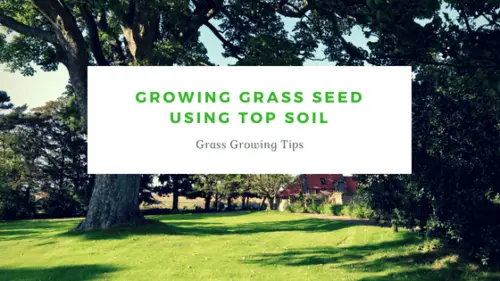Top Soil and Grass Seed
I have personally grown grass seed using only top soil in two areas of my lawn. I did not use the expensive lawn soil sold for about $7.00 a bag at Lowe’s or Home Depot. I simply used the cheap $1.50-$2.00 per bag top soil, lightly raked in the seed, and water at least two times a day until the grass was thick.
While top soil can grow grass seed, I have had the best results mixing top soil with compost or manure. I used a 75/25 mix of top soil to compost/manure over the area that I wanted to seed. I raked the mixture level and removed any debris or rocks that may of been in the existing grass or in the cheap top soil. Then the seed was spread over the soil and gentle raked into the soil. I added starter fertilizer as the last step and then religiously water daily for several weeks.
If you glance over the customer review section of a website that sells grass seed, you will likely see a complaint by at least one person stating that their seed did not germinate or came in thin. Yes, there is bad seed out there. However, I would suspect that many of these failures come from user error. Please consider some of the below tips before you begin planting your seed. Grass seed is not cheap so you want to get it right the first time around.
Planting Grass Seed Tips
- Grass seed grows best in spring and fall. Early fall is ideal. Avoid planting in the summer. You likely will not like the results.
- Water two times a day or more if it is hot or windy. If you do not have a sprinkler timer, this can admittedly be a big pain. However, keeping the seeds moist is vital for growth.
- Do not excessively water the seed. This will flood the soil and the seeds will be disturbed from their original resting place where they are attempting to grow. During your first few watering sessions, be sure to monitor the soil to ensure you are not flooding the top soil.
- Considering covering the soil with lawn straw or a light layer of peat moss. This will deter animals such as birds from feasting on your seed. Straw or peat moss will also help keep the seed moist as it provides a layer of protection from the elements. Additionally, peat moss is said to improve seed germination rates. I have personally had great success using a very thin layer of peat moss.
- Do not expect a thick lawn in a matter of days. Do research on the germination rate of the type of grass seed that you buy. The growth rates can vary greatly from seed to seed. However, most grass seeds will germinate within a few weeks, but will take several weeks after that to nicely thicken up.
- Do not use weed and feed, crabgrass preventers, or other fertilizer that are not designed for new grass. Stick with products, such as starter fertilizer, that are made to feed new grass. Other products will kill the new grass and seed.
- Measure the area you want to seed before you start. You will need to determine the square footage of the area in order to determine how much seed to lay down. The grass seed bag or manufacturer will provide information on the number of pounds of seed to put down per square foot. Follow these directions so that you are not putting down too little or too much seed. Planting the appropriate amount of seed is essential to achieving good results.
- Don’t be afraid to reseed over areas that you notice are not growing in. It is better to tackle these problem spots right away than deal with patchy grass down the road.
- Buy good grass seed! Spend a few extra dollars if it means getting fresh and quality grass seed. There are a lot of types of grass seed (Kentucky Bluegrass, Tall Fescue, Rye, shade mixes, regional mixes, etc.) and numerous brands. Take some time to research the best seed for your regional area.


